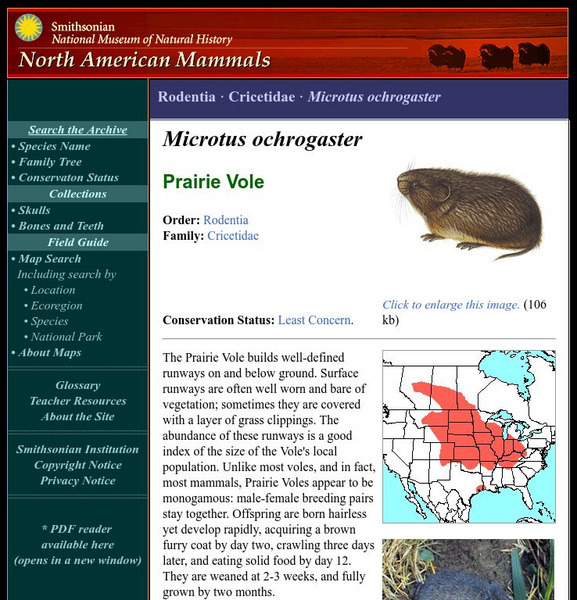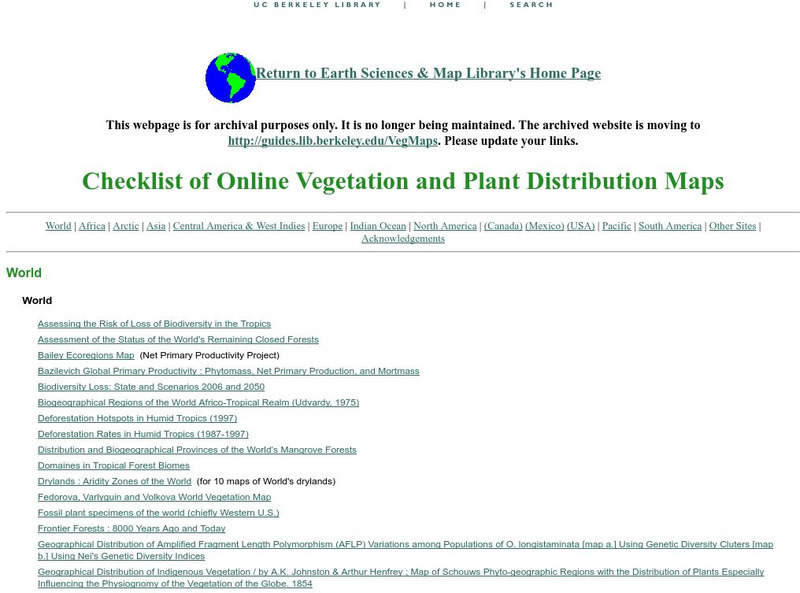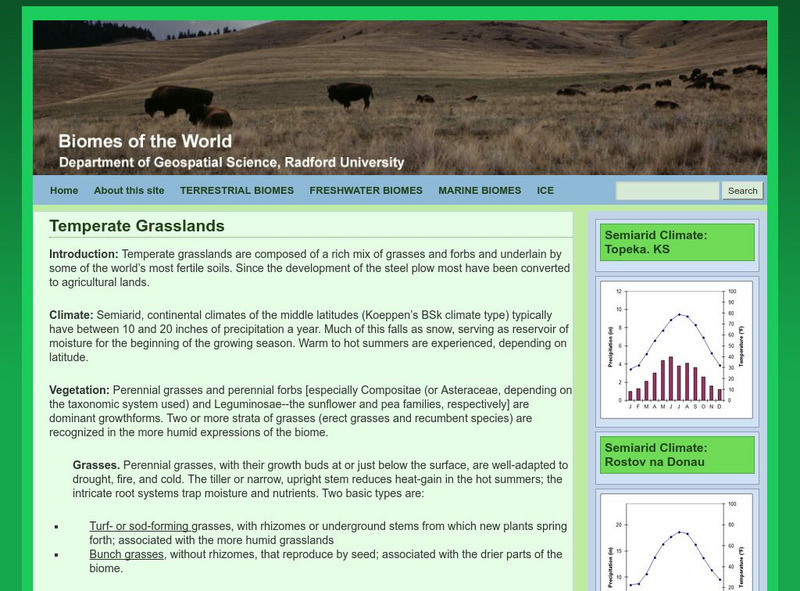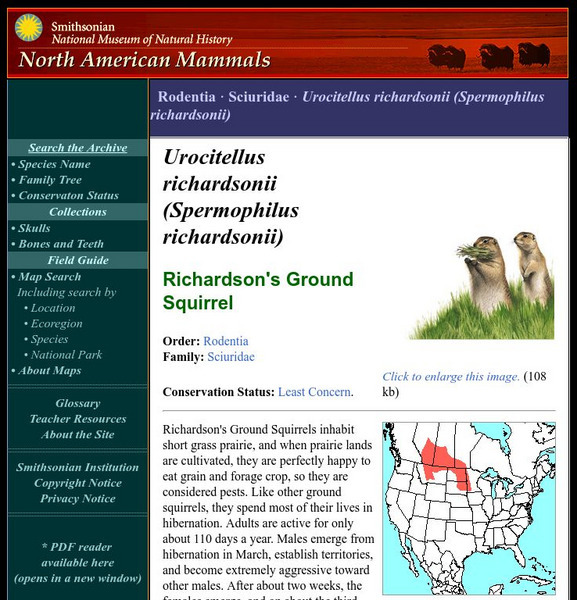Curated OER
American Bison
In this bison worksheet, students read several paragraphs about the American Bison. Students learn about its history and its current status and answer questions about the text.
Other
Camp Silos: Exploring the Prairie
An excellent site for studying the Iowa prairie. Offers wonderful facts and interactive activities for students to do individually or as a group. Identifies national standards and lesson plans for the teaching of prairie life. Provides...
Environmental Education for Kids
Eek!: Habitats: Prairie
Learn what prairies are, about the plants and wildlife that live there, and about the environmental efforts being made to restore them.
Other
Kansas Wildflower and Grasses
A list of Kansas Wildflowers and Grasses. Includes photos and information.
Environmental Education for Kids
Eek!: Prairie Plants
Prairie plants are adapted to spend all day in the sun without drying out. Learn about some prairie plants here.
Nature Conservancy
Nature Conservancy: Nash Prairie Preserve
Explore the beauty of America's prairies and examine efforts to preserve this vanishing part of America's landscape.
Smithsonian Institution
National Museum of Natural History: American Mammals: Prairie Vole
The Prairie Vole builds well-defined runways on and below ground. Surface runways are often well worn and bare of vegetation; sometimes they are covered with a layer of grass clippings. Learn more about the Microtus ochrogaster, more...
Smithsonian Institution
Smithsonian National Zoo: Zoogoer Magazine: Rediscovering a Fragile Frontier
This article deals with a variety of topics related to the Prairie biome. Topics covered include More than Just Waving Grass, Birds of a Feather, Bison: From Abundance to Absence, and more.
PBS
Nh Pbs: Nature Works: Grasslands
NatureWorks offers some great information about grasslands. Learn what grasslands are, the difference between tropical and temperate grasslands, the different types of prairie grasses, and grassland animals.
Other
Friends of Neal Smith National Wildlife Refuge: Homepage
You can visit the tall grasses on Iowa. There is 7,000 acres on this refuge. You can see elk and buffalo. You can go on an auto tour, or go hiking on a trail.
University of California
Ucmp: The World's Biomes
The University of California Museum of Paleontology hosts this site devoted to the study of the earth's biomes, which are the world's major communities, classified according to the predominant vegetation and adaptations of organisms to...
University of California
U.c. Berkeley Libraries: Plant Distribution Maps
This resource provides a list of online maps of world vegetation such as biomes, forests and plants.
Other
Radford University: Temperate Grasslands
This is part of a virtual geography project from Radford University. Learn about the climate, vegetation, grasses, soil and fauna of the temperate grasslands.
Other
Digital Revolution: Homestead National Monument of America
This information about the Homestead Act and homesteaders has been garnered from the National Park Service. Use the links at the bottom to find out about the history of the Act, the lives of the homesteaders, and what a tall grass...
Missouri Botanical Garden
Missouri Botanical Garden: Grasslands
This site from the Missouri Botanical Gardens provides general information about different kinds of grasslands and the plants and animals of that type of region.
Smithsonian Institution
National Museum of Natural History: American Mammals: Richardson's Ground Squirrel
Richardson's Ground Squirrels inhabit short grass prairie, and when prairie lands are cultivated, they are perfectly happy to eat grain and forage crop, so they are considered pests. Like other ground squirrels, they spend most of their...
Smithsonian Institution
National Museum of Natural History: American Mammals: Thirteen Lined Ground Squirrel
Thirteen-lined Ground Squirrels are often seen standing on their hind legs on roadsides or other places where grass is mowed, such as lawns, golf courses, or cemeteries. The squirrels probably once lived in short-grass prairie, and some...
Smithsonian Institution
National Museum of Natural History: American Mammals: Merriam's Pocket Mouse
Merriam's Pocket Mice are found in short-grass prairie, desert scrub, and open, arid brushland. They are most common where the vegetation is dense enough to provide them with seeds and some protection from predators, but not so dense...
Smithsonian Institution
National Museum of Natural History: American Mammals: Ord's Kangaroo Rat
By occupying the short grass prairie of the Great Plains, and a variety of habitats where there are fine-textured, sandy soils, Ord's Kangaroo Rat has managed a truly enormous geographic distribution. The varied habitats that it occupies...
Other
Great Plains Nature Center: Flora and Fauna
A description of the animals and plants of the Great Plains. It also includes a map showing the extent of the plains.
Curated OER
Educational Technology Clearinghouse: Maps Etc: North America, Vegetation, 1911
A map from 1911 of North America, Central America, Greenland, and the Caribbean to Puerto Rico showing the areas of primary vegetation types for the region. The map is color-coded to show areas of forests, areas of woodland, grass, and...
Curated OER
Etc: Maps Etc: Vegetation Distribution of South America, 1911
A map from 1911 of South America showing the distribution of vegetation types. The map is color-coded to show regions of forests, regions of woodlands, grass, and cultivation, regions of steppes and prairies, desert regions, and regions...















